- Bernard Preston homepage
- Yellows
- Easy Butternut Squash Soup
Easy Butternut Squash Soup
This easy butternut squash soup recipe need give you no concerns over its glycemic properties; it is not fattening and is full of beta-carotene, precursor to vitamin A. It is definitely one of my choice foods.
The basic ingredients for our easy butternut squash soup are as follows.
- One butternut. Actually I now just fill the pressure-cooker; that could mean two or three, depending on the size.
- A sweet-potato, or the usual sort of spud.
- Other gourds that are in season, such as a susu[3].
- One large onion.
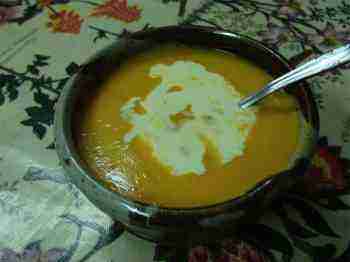
This page was last updated by Bernard Preston on 6th February, 2024.
This recipe is certainly my all-time preferred hors d'oeuvre. Huh, I love many and have at least half a dozen favourites but this is the queen of the kitchen; but only in winter oddly.
It is absolutely delicious and very easy to
make. It is known as winter-squash in
America by the way; you can store them in a cool basement for months.
One of its many virtues is that orange colour; a rich source of beta-carotenes that are the precursor of vitamin A. A deficiency causes nearly half a million children every year to become blind. Let your food be your medicine and get your supplements from the garden; for a fraction of the price.
Actually be careful of beta-carotene supplements; you can overdose. Because it is fat soluble and stored in the adipose tissue they can be dangerous. There is an increased risk of nasty tumours too[2]. I'm not exaggerating.
There is only one bit I hate and that is peeling them. You really should wait until the skin is a nutty-brown colour; and then it is quite hard to pare. She who is always right laughs at me. Only a man could find it difficult.
So be it if you are a male; or rope in the good wife to pare your winter squash.
Now we have a new peeler that makes it much easier; and a pressure-cooker. It is even quicker and simpler. Scroll down to the bottom of the page for a sighting; eureka, I have it.
Easy Butternut Squash Soup
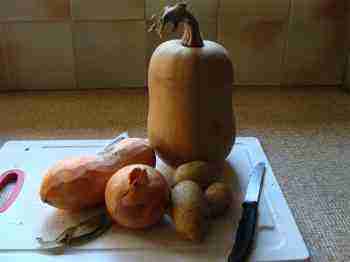
- One medium sized butternut.
- One large sweet-potato.
- One ordinary potato is optional. Omit if you have a weight problem; it is glycemic.
- 1 small onion, 6 cloves of garlic and 2 cm piece of ginger.
- 1 tsp of freshly-roasted and ground cumin.
- A couple bay-leaves and fresh green coriander.
- Half a can of coconut-cream.
- A teaspoon or two of masala-spice.
- 1 tsp of freshly-roasted and ground cardamom.
- A washed and cored apple.
- 3 peppadews or slither of chili if you like it spicy; I do.
- One star-anise gives it a different flavour. I like it occasionally for a change.
- Half a stick of cinnamon.
- A few lemongrass sticks.
- Vegetable or chicken stock.
- Gently fry the onion, garlic and ginger in 1 TBSP of coconut oil for a few minutes; add the other spices and salt.
- Peel the butternut, remove the seeds and cut into large pieces. Add to the pressure cooker.
- Place cinnamon sticks, anise and lemongrass on top, preferably in a small bag; bay leaves too.
- Add the apple.
- Pressure cook for 20 minutes with 4 cups of your stock of choice.
- Peel away the tough outer leaves of the lemongrass.
- Liquidise with a stick blender.
- Add the coconut cream and blend further.
- Serve hot or cold, sprinkled with green coriander.
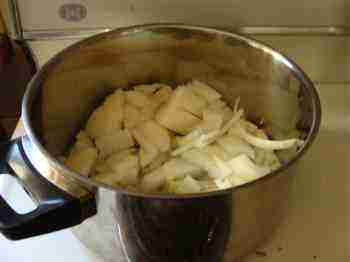
Cinnamon and diabetes make an interesting topic. Type-2 is caused by the loss of sensitivity of the cells to insulin, the hormone that stores raised blood glucose as fat. Fascinating research shows that the spice can reverse this process.
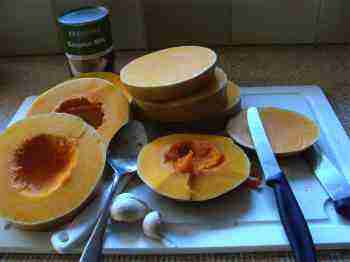
So too pumpkin for diabetes makes interesting reading; research shows an astonishing drop in both blood-glucose and the amount of insulin needed in critically ill patients in ICU.
Pumpkins and butternut both belong to the same Cucurbita family. They make wonderful meals, easy to prepare and inexpensive; and with huge benefits for not only diabetics but all of us. Good control of blood sugar and high insulin-sensitivity are foundational to our wellbeing.
A bowl of this easy butternut soup once a week would save half a million children from becoming blind each year.
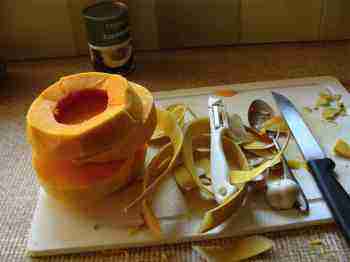
The wonder of worm farms consumes kitchen biodegradable waste and produces a wonderful liquid manure. The excess wrigglies go to feed the hens. That's the beauty of permaculture; work with nature rather than against it, utilizing the contents of the compost-bin on the property.
Then feed the worm-wee to your butternut; we call it the synergy of green living.
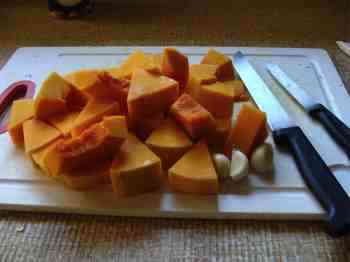
This soup is very rich in phytosterols and soluble fibre. Don't be anxious about your cholesterol from the fat you use in cooking the onions. In any case top research confirms that butter is back, particularly if you are eating these kinds of foods on a daily basis.
- "What are phytosterols" and how they help with high-cholesterol.
- FOODS THAT LOWER CHOLESTEROL naturally.
- Autumn veggie garden
Copy and paste into the Site Search engine above for more information.
Many soups give me indigestion; one of things I love about butternut, is that I can enjoy it at night, even with our homemade-bread, and not be
anxious about being woken at midnight with massive heartburn. On that score, when in season I will often use a susu, also known as chaote squash, instead of sweet potato; it is very soothing for the stomach.
So it is spring; that means it is time to start planting butternut squash. They are greedy feeders and just love a compost-heap. They have quite a long growing season, so you want to get the first seeds into the ground as soon as the danger of frost is over.
Just keep back a handful of seeds from the best fruit from last season; successive plantings mean you will have this easy butternut-squash soup in late summer and, if you sow enough, then right through a mild winter.
They keep beautifully in the cellar through the winter if you allow them to stay on the vine until the plant dies off completely; choose those with a dark nutty-brown colour.
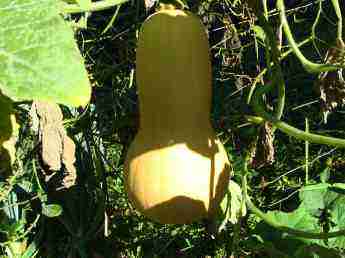
The beauty above is not quite ready for picking; the vine has not died back completely and it has not reached that nutty-brown colour. Grown in deep compost it weighed in at nearly six-pounds when we turned it into our easy butternut soup.
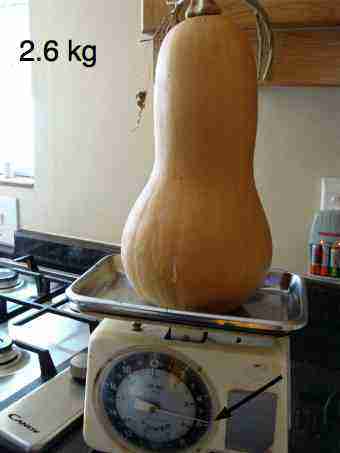
See now the perfect colour, a month later. Let your own vegetables nourish you. No chemicals, sprays or PCBs, with only deep homemade-compost to feed the plant. Oh, and the ammonia provided by the pole beans grown early in the summer on this fence; nitrogen fixation bacteria are vital for the organic gardener.
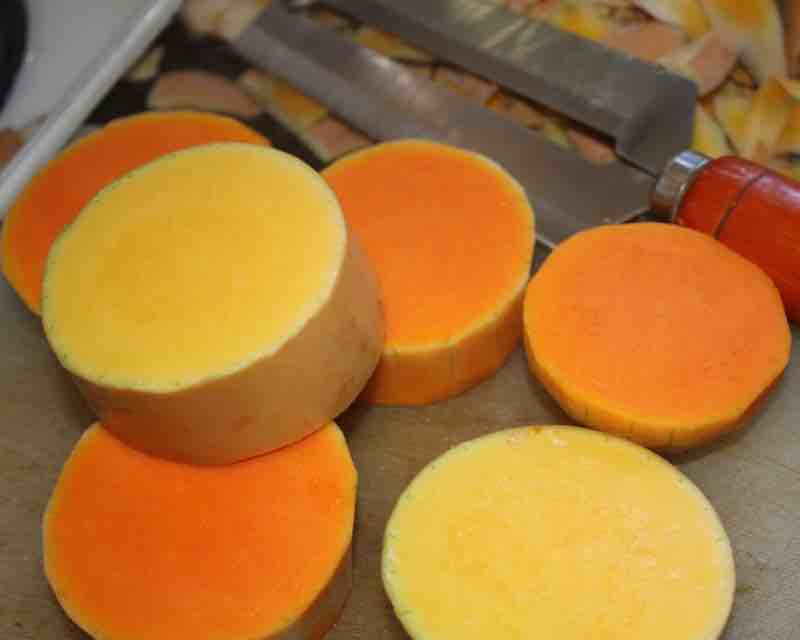
Unlike giant pumpkins these beauties are absolutely delicious. The best ones actually grow in the compost-pile without being planted; seeds from the overflowing kitchen waste germinate spontaneously.
Actually the kitchen-waste now goes first to the worm farm so the rats do not get into it; hide the butternut seeds deep in the compost pile.
We will seed one of the compost piles which is retained specifically for gourds like this; an organic butternut is king.
But if you are looking for a different butternut squash soup recipe then I recommend using a chicken bones bouillon. Simply freeze the left-over carcass until you have accumulated sufficient and then boil them for about an hour.
Better still pressure cook the chicken bones for ten
minutes; it extracts the cartilage precursors that are so nutritious for
our joints; it is a big time and energy saver especially you are reliant on solar-energy.
The chicken-stock improves the flavour; the protein and fat lowers the glycemic index of the butternut and potato and there is interesting research from Harvard school of medicine on the benefits of the extract for arthritic sufferers.
The questionable best option which is a bit of a fag is to wrap your butternut squash chunks in foil and place on a hot barbecue for an hour, preferably with some nice old oak used for smoking; or otherwise under the grill. I do not usually bother unless we are also cooking our recipe for sesame chicken; slow food made fast is our slogan.
By the way this is a very large site; use the site search function in the navigation bar on the left to find things that might interest you; this site map gives you the overall picture.
Putting your vegetables under the grill raises the glycemic-index significantly so if you have a weight problem, or a tendency to diabetes then I certainly do not recommend making roasted butternut squash soup recipe; it makes it more fattening. Odd, is it not? It is nice for a change though if you have no need to be strict with the pounds.
I find it very odd that butternut is completely banned from the Banting diet. It is relatively high in carbohydrate but it is the very best type; the trick is to keep the load down with a small portion.
The cell-walls of plants promote a happy stomach and colon so it is a form of starch that is extremely nutritious. The pectins make up a large part of that carbohydrate; they are the soluble fibre that we are so short of in the modern western diet.
It also has a low glycemic index and does not produce an insulin rush; in the large intestine it is feasted upon by the microbiome, those friendly bugs that turn starch into short-chain fatty acids rather than blood glucose.
Butternut is one of the richest source of the vitamin A precursor called carotene; not just the beta form but the others too, making up a wonderful prevention package of antioxidants; researchers are saying nearly one half of us will get metastatic disease. Is it not your desire too not to be numbered amongst them?
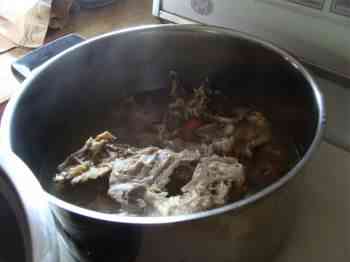
- Best chicken bone broth bouillon
- Planting sweet potatoes
- Banting diet - type it into Site Search in the main menu.
Butternut peeler
Every now and then Lady Luck smiles on one; I recently happened upon a street vendor doing a demonstration with a butternut peeler; knowing how difficult it is to do, I was immediately impressed and parted gladly with R50, about $4.
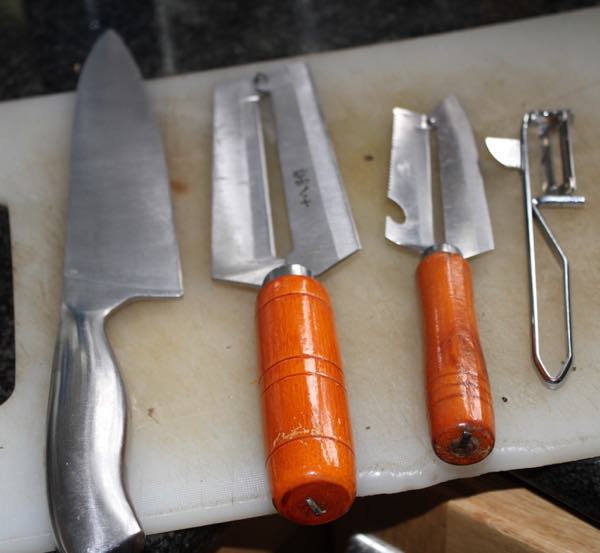
A heavy cleaver, two slightly different butternut peelers, and the best potato peeler in the world are what you need to make our easy butternut squash soup.
Winter squash as the Americans call it, has a thick skin that is beyond the ordinary potato peeler.
Easy butternut squash soup
Easy butternut squash soup need give you no concerns over its glycemic properties.
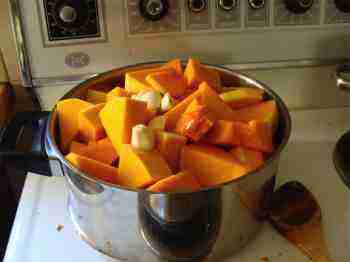
Peeling the butternut squash, sometimes called winter squash soup, is a pain, for me anyway. So I used to slice them in rings about an inch thick first.
I will soon be doing an upgrade on this page. I have found a new paring knife that makes peeling butternut a breeze; and a heavy duty block knife that saves you from a nasty gash.
Scoop out the seeds with a strong spoon. They actually make a very nutritious roasted snack if you simply wash them first and then pop them in the oven with a bit of oil and favourite spices.
Peel the rings. I grit my teeth, watch my fingers and get on with it; you need a good strong peeler. Chop them into large pieces; they cook more quickly.
Peel and quickly chop the onion. Big bits are fine because you are going to liquidise it anyway. Drop them into your largest pot together with a chunk of butter. Never fry with seed oils or margarine; use olive oil if your cholesterol is very high.
Peel and chop the potatoes, add the bay leaf and garlic
and strain in the chicken bones stock; you are just about ready to make your easy butternut squash soup.
Boil it until it is soft; about half an hour. Remove the bay leaves from your easy butternut squash soup, add the coconut milk and liquidise with a stick blender.
Pop the other ingredients into your pot, and cover with a tight fitting lid; then boil until it is soft; about half an hour.
Some folk like to add some curry powder; I often whir up some coriander seeds and then add half a jalapeno too. Make sure you include the seeds and especially the white placenta; that's where most of the anti inflammatory capaicin is to be found. Odd, is it not, that a hot chili should help painful joints and muscles?
You need a large garden to grow sweet potatoes and butternut but by gosh
they are rewarding; they require zero attention once you've planted
them. We are reaping both right now in the late autumn; fantastic fruit of the earth.
There is some controversy about coconut milk. It is high in cholesterol, but being a vegetable source, I'm not concerned.
To be
safe, if your total cholesterol is high, do not add the coconut milk and
cream. But research is now fingering refined carbohydrate and not saturated fat as the chief source of our cardiovascular diseases.
Every family should have one of these pressure cookers; it reduces the time by two-thirds. They are super safe today; pay the extra and get stainless steel rather than aluminium.
Pressure-cookers come on special for a very reasonable price periodically; just wait patiently.
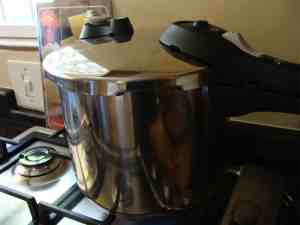
Newsletter
Our newsletter is entitled "create a cyan zone" at your home, preserving both yourself and Mother Earth for future generations; and the family too, of course. We promise not to spam you with daily emails promoting various products. You may get an occasional nudge to buy one of my books.
Here are the back issues.
- Lifestyle and ideal body weight
- What are ultra-processed foods?
- Investing in long-term health
- Diseases from plastic exposure
- Intensive lifestyle management for obesity has limited value
- A world largely devoid of Parkinson's Disease
- The impact of friendly bacteria in the tum on the prevention of cancer
- There's a hole in the bucket
- Everyone is talking about weight loss drugs
- Pull the sweet tooth
- If you suffer from heartburn plant a susu
- Refined maize meal and stunting
- Should agriculture and industry get priority for water and electricity?
- Nature is calling
- Mill your own flour
- Bake your own sourdough bread
- Microplastics from our water
- Alternative types of water storage
- Wear your clothes out
- Comfort foods
- Create a bee-friendly environment
- Go to bed slightly hungry
- Keep bees
- Blue zone folk are religious
- Reduce plastic waste
- Family is important
- What can go in compost?
- Grow broad beans for longevity
- Harvest and store sunshine
- Blue zone exercise
- Harvest and store your rainwater
- Create a cyan zone at your home
Glycemic-index of butternut
Back to the glycemic-index of our easy butternut squash soup recipe. Is it fattening? Is it nourishing?
One needs to focus on the glycemic index of the whole dish, rather than the individual parts. Yes, potato does have a high GI and, if you are significantly overweight, I would add less potato or none.
Butternut has a GI of 51 which places it firmly in the low range. Neither the onion nor the sweet potato are a problem.
So why is butternut banned from so many of the fad diets? Frankly, I do not get it. Sparkling wellness is not just about keeping your weight down; cut out those foods that are rich in the anti-oxidants, essential vitamins and minerals to lose weight at your peril. Hence the "modified Banting diet" that we espouse.
I have no desire to suggest you trade obesity for metastatic tumours.
But if you are concerned, you can lower the glycemic index of a food by adding protein and fat; enter our coconut milk.
Use the Site Search function to find the links the link to the "modified Banting diet."
Interestingly butternut has quite a large amount of the omega 3 fatty acid ALA which gives it anti-inflammatory properties; it's another reason why the GI of our soup is low.
There is not much protein in butternut which is why I recommend adding coconut milk to make it a complete food.
Once you have added the coconut milk and liquidised your easy butternut squash soup, then serve it steaming hot; voilà. Tuck in with some low GI bread. White rolls should never appear on your table; a few seconds on the lips, a lifetime getting rid of them.
- Foods to avoid high cholesterol
- Low GI loaves - so easy with a bread-maker. Six minutes work, plus a five hour wait, of course; all the while the tempting aroma of baking.
Carotenoids
Carotenoids are the coloured phytochemicals in our fruit and veg that keep malignant tumours at bay; try to eat ten a day. That might seem like hard work, but if you add just a sprig of parsley to your scrambled egg, that would count as one; don't get neurotic about measuring it out.
With all that stunning yellow colouring (tip: pick out your butternut winter squash when they've gone a deep nutty-brown colour) winter squash are of course full of vitamin A.
Let your food be your medicine; this easy butternut squash soup is a wonderful source of carotenoids and vitamin A.
Vitamin A
Vitamin A is absolutely vital for our wellbeing. Whether it is your eyes, stimulating the beta-cells in the pancreas or your immune system, we simply cannot live without it.
Beta-carotene is a precursor of vitamin A; just wonderful in our easy butternut squash soup.
It is slightly higher in carbohydrate but they are nourishing complex sugars; that is why it is such fun for the sweet tooth. It has more than broccoli, but lower in fat; it is even surprisingly good in the benefits of folate and in fact five B vitamins. We normally associate them with green leafy vegetables.
Butternut is just a good all round vegetable and I recommend you include it in your diet once or twice a week, even if you are overweight. Several studies have shown that those polysaccharide carbs have sugar-regulating properties; they do not give you an insulin rush and are a perfect food for diabetics too[1]. Do limit the serving size though.
Roasted butternut squash recipe
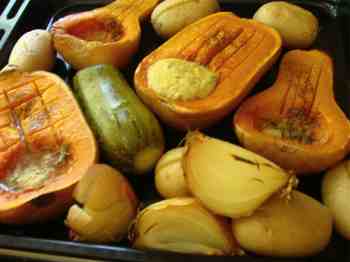
Roasted butternut squash recipe has only one advantage over the soup, but it is a big one. You do not have to peel the fruit.
But it comes with a disadvantage too; roasted vegetables are far more fattening. The enzymes in the small intestine are able to digest them more easily giving a little blood sugar surge.
Retro your butternut soup
Simply cooling any starch, like your easy butternut squash soup, overnight in the fridge, and reheating it the next day allows the carbohydrate to retrograde. The polysaccharide molecules realign making it more difficult for the enzymes to digest in the small intestine to form glucose.
Instead some of the starch passes through to the colon becoming what is known as a pre-biotic; food for the umpteen millions of bacteria, protozoa and yeasts in the happy tum.
Read more about reheating resistant starch when you have some extra time.
Butternut soup in bread dough
Few ingredients will improve both the flavour and texture of your homemade bread better than adding a couple tablespoons of butternut soup to the dough. I now make it virtually every week simply to enhance our artisan loaf.
Potassium
The squash family in general, including butternut, is rich in potassium; it is an essential mineral involved in lowering blood pressure. Is it any wonder that heart disease and stroke are such killers in the West when less than 2 percent of folk are getting the mandatory 4,000 mg per day?
There are 500 mg of potassium in a cup of butternut.
Your greens, legumes and bananas are other good sources. Eggs Hilton and a smoothie, along with this easy butternut squash soup are how we keep our potassium levels up. It is such a pleasure not having to take blood pressure medication every day.
Our perfect butternut smoothie is another great favourite.
Food as medicine
The pumpkin family has long been used as a natural treatment for diabetes[1]; three known compounds, beta-carotene, trigonelline and vitamin B3 all have a powerful affect on regulating blood sugar. There are probably others too.
Researchers have now found that the great majority of those suffering from T2D can be brought completely into remission by dietary interventions and walking after starchy meals. Food as medicine is the new buzzword for those suffering from the disease.
Look upon this easy butternut squash soup as medicine; but only small portions for those suffering from diabetes. Keep the glycemic load down.
Choice foods
Nutritious choice foods must include many carotenoids, for example. You and your family will be sickly and stunted without them; our easy butternut squash soup is a great start to putting that right.
Easy butternut squash soup or our roasted recipe should be on the menu weekly. We enjoy it daily right through the winter. Then there is no need to be swallowing vitamin pills.
USEFUL LINKS
- Confused about LDLs, saturated, polyunsaturated, monos? Olive garden nutrition explains it all.
- EASY SOUP RECIPES home page …
When browsing use right click and "Open Link in New Tab" or you may get a bad gateway signal.
Find the links to those topics highlighted in bold by copying and pasting into the Site Search function in the navigation bar above.
Support this site
If you like the tenor of this Bernard Preston site, then you will love my books. Dirt cheap on your Kindle or tablet from Amazon.
This is a spicy trilogy; some like it hot. Like some easy butternut squash soup with a little chili added.
Bernard Preston

Did you find this page interesting? How about forwarding it to a friendly book or food junkie? Better still, a social media tick would help.
- Bernard Preston homepage
- Yellows
- Easy Butternut Squash Soup
Address:
56 Groenekloof Rd,
Hilton, KZN
South Africa
Website:
https://www.bernard-preston.com